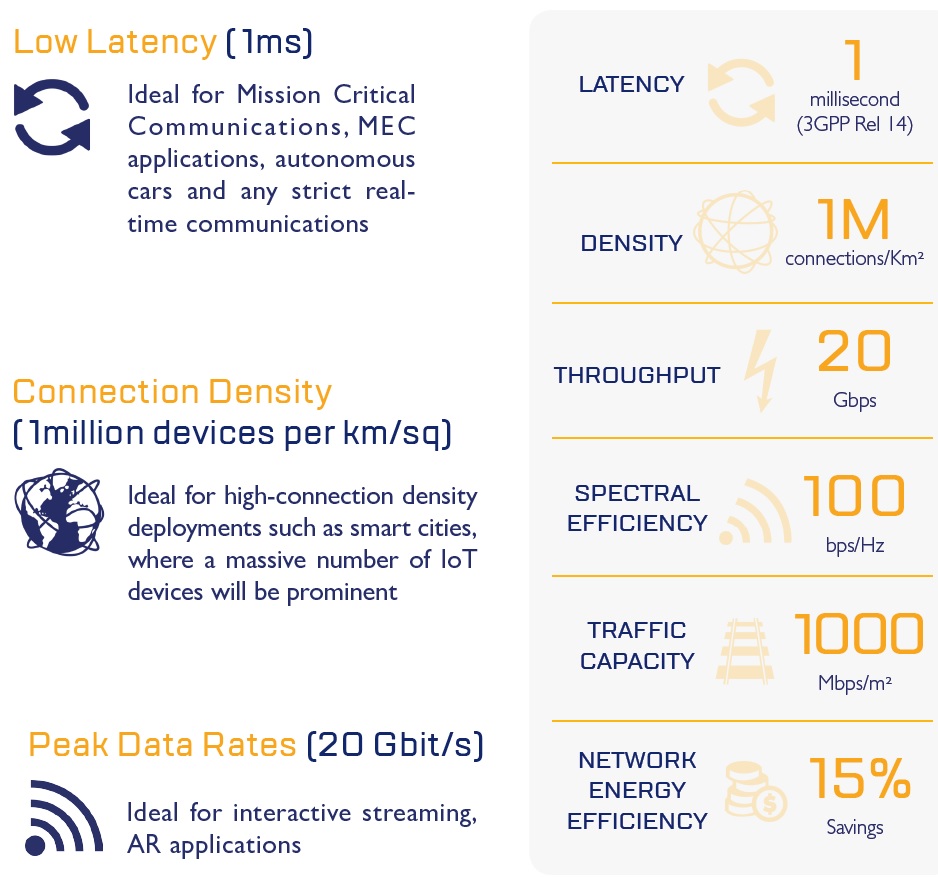The continuous traffic growth and service demands on the 4G systems, such as real-time streaming, gaming, smart applications, multiple devices per consumer, autonomous self-driving cars, cloudification of systems and much more, have made it difficult for MNOs to handle demand while ensuring QoS and experience to the end user.
To fulfill these demands, the fifth generation of cellular networks was introduced. 5G promises to allow more connections, much higher throughputs, and lower latency.
Based on industry standards and enhanced with customizable features and automated processes, EDX is built to support 5G networks in any stage of the system life cycle and ensure you meet performance and budgetary requirements.
What is 5G Capable Of?

Currently, 5G applications fall into the following use cases as defined by IMT-2020:
Enhanced Mobile Broadband (eMBB)
The first step in 5G is to take what we currently have and make it better: faster data rates and improved capacity for enhanced user experience, reduce latency & improve connectivity to ensure service whether in urban or rural areas, in crowded venues or moving vehicles.
- High-speed internet access
- Improved broadband connectivity
- 3D 4K video streaming and gaming
- Higher capacity for broadband access in densely populated areas, stadiums & city centers
- Ultimately enable VR and AR, real-time video monitoring and 360 degree video
Ultra-Reliable Low-Latency Communications (URLLC)
Ultra-Reliable Low-Latency communication provides reliability and seamlessness that cannot be achieved with 4G or WiFi, improving safety and taking Mission Critical Communications to the next level.
- Industrial automation/smart factory
- Remote healthcare
- Autonomous driving
- Cloud-based AR/VR
- Improved safety in Smart Grid electrical distribution
Massive Machine Type Communications (mMTC)
5G provides the opportunity for the internet of things to expand beyond consumer use. A growing IoT for applications in healthcare, transportation, utilities, energy, etc., require the reliable, high capacity, low latency and scalable networks of 5G, enabling a massive IoT and further autonomizing machine-to-machine communication.
- Smart City
- Connected Vehicles
- Smart Agriculture
- Smart Metering
- Asset Monitoring
All in all, 5G will do much more than significantly improve your network speed. It will allow billions of connected devices gathering and sharing information in real time. It can allow data to be shared with very low, or almost without latency.
Beyond being able to download a full-length HD movie to your phone in seconds (even from a crowded stadium), 5G is really about connecting things everywhere – reliably, without lag – so people can measure, understand and manage things in real time.
Frequencies
5G Frequencies 5G spectrum spans across 0.4 GHz to 100 GHz, low, mid and high band and frequencies are split into FR1 (4.1 GHz to 7.125 GHz) and FR2 (24.25 GHz to 52.6 GHz). One big factor of 5G is acquiring spectrum to fit your needs. The spectrum used will enable planners to provide areas with specific needs coverage, whilst using equipment such as MIMO to obtain the desired data rates and coverage footprint.
These frequencies range as following:
Low band: 410 MHz to 1 GHz
- Limited capacity with large area coverage and indoor penetration
- Peak data rate tops out at approximately 200 Mbps
- Required to create greater equality between urban and rural broadband connectivity
Mid band: 1 GHz to 7 GHz
- Good for urban deployment with increased capacity
- Peak data rate tops out at approximately 2 Gbps
- The majority of commercial 5G networks are relying on spectrum within the 3.3-3.8 GHz range
High band: 24 GHz to 100 GHz (mmWave)
- Limited coverage with potential for very high capacity
- Peak data rate tops out at approximately 10 Gbps
EDX and 5G
Whether you are working in Sub-6 or mmWave frequencies, use EDX’s 5G solution to apply any FR1 and FR2 requirements along with bandwidth, SCS, numerology, vendor MIMO configurations and equipment to ensure your systems meet performance and budgetary requirements whether working in rural, urban or mixed service areas.








